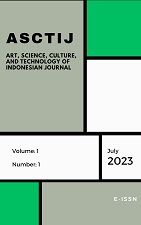The Applied Media Aesthetics to Visual Communication Design Works Based on Augmented Reality
Abstract
Full Text:
PDFReferences
Supatmo, “Fenomena Estetikasi Kehidupan Sehari-hari dalam Seni Rupa Indonesia.,” Imajinasi, vol. 1, no. 2, 2012.
H. Zettl, Sigh Sound Motion; Apllied Media Aesthethics. Boston: Cengage Larning, 2015.
H. Mustafa, “Perilaku Manusia Dalam Perspektif Psikologi Sosial,” Jurnal Administrasi Bisnis, vol. 7, no. 2, 2011.
D. Afrilia, “Merasakan Energi Positif Ketika Kita Terhubung dan Menyatu dengan Alam,” Humaniora, 2021. https://www.goodnewsfromindonesia.id/2021/05/21/merasakan-energi-positif-ketika-kita-terhubung-dan-menyatu-dengan-alam
M. R. Fadli, “Memahami desain metode penelitian kualitatif,” HUMANIKA, vol. 21, no. 1, pp. 33–54, Apr. 2021, doi: 10.21831/hum.v21i1.38075.
E. Fernie, Art History and Its Methods: A Critical Anthology. London: Phaidon Press Limited, 1995.
M. A. Yahya and A. Dahanayake, “A Needs-Based Augmented Reality System,” Applied Sciences, vol. 11, no. 17, p. 7978, Aug. 2021, doi: 10.3390/app11177978.
I. P. Sari, A. H. Kartina, A. M. Pratiwi, F. Oktariana, M. F. Nasrulloh, and S. A. Zain, “Implementasi Metode Pendekatan Design Thinking dalam Pembuatan Aplikasi Happy Class Di Kampus UPI Cibiru,” Edsence: Jurnal Pendidikan Multimedia, vol. 2, no. 1, pp. 45–55, Jun. 2020, doi: 10.17509/edsence.v2i1.25131.
Y. Chen, Q. Wang, H. Chen, X. Song, H. Tang, and M. Tian, “An overview of augmented reality technology,” J Phys Conf Ser, vol. 1237, no. 2, p. 022082, Jun. 2019, doi: 10.1088/1742-6596/1237/2/022082.
A. Aluri, “Mobile augmented reality (MAR) game as a travel guide: insights from Pokémon GO,” Journal of Hospitality and Tourism Technology, vol. 8, no. 1, pp. 55–72, Mar. 2017, doi: 10.1108/JHTT-12-2016-0087.
A. E. Ramadhana, A. Z. Mansoor, and N. Haswanto, “Kajian Daya Tarik Visual pada Desain Karakter Pokémon,” Wimba : Jurnal Komunikasi Visual, vol. 5, no. 2, Apr. 2015, doi: 10.5614/jkvw.2013.5.2.6.
I. Mustaqim, “PENGEMBANGAN MEDIA PEMBELAJARAN BERBASIS AUGMENTED REALITY,” Jurnal Edukasi Elektro, vol. 1, no. 1, Aug. 2017, doi: 10.21831/jee.v1i1.13267.
R. Juwono, “ANDROID BASED AUGMENTED REALITY FOR DIGITAL VISUAL NAVIGATION,” Computer Based Information System Journal, vol. 7, no. 2, pp. 67–71, Sep. 2019, doi: 10.33884/cbis.v7i2.1397.
DOI: https://doi.org/10.24821/asctij.v1i1.10169
Refbacks
- There are currently no refbacks.






D1.png)